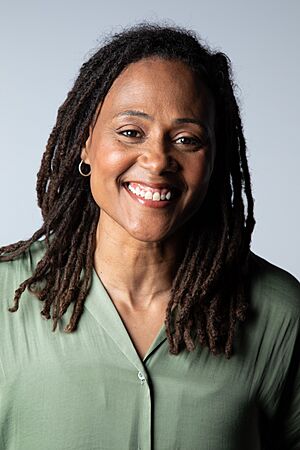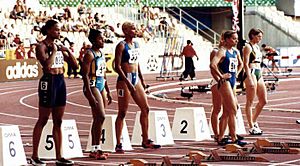Marion Jones facts for kids

Marion Jones in April 2024
|
|||||||||||||||||||||||||||||||||||||||||||||||||||||||||||||||||||||||
| Personal information | |||||||||||||||||||||||||||||||||||||||||||||||||||||||||||||||||||||||
|---|---|---|---|---|---|---|---|---|---|---|---|---|---|---|---|---|---|---|---|---|---|---|---|---|---|---|---|---|---|---|---|---|---|---|---|---|---|---|---|---|---|---|---|---|---|---|---|---|---|---|---|---|---|---|---|---|---|---|---|---|---|---|---|---|---|---|---|---|---|---|---|
| Born | October 12, 1975 Los Angeles, California, U.S. |
||||||||||||||||||||||||||||||||||||||||||||||||||||||||||||||||||||||
| Height | 5 ft 10 in | ||||||||||||||||||||||||||||||||||||||||||||||||||||||||||||||||||||||
| Weight | 150 lb | ||||||||||||||||||||||||||||||||||||||||||||||||||||||||||||||||||||||
| Sport | |||||||||||||||||||||||||||||||||||||||||||||||||||||||||||||||||||||||
| Country | United States | ||||||||||||||||||||||||||||||||||||||||||||||||||||||||||||||||||||||
| Sport | Track and field | ||||||||||||||||||||||||||||||||||||||||||||||||||||||||||||||||||||||
| Event(s) | 100 meters, 200 meters, long jump | ||||||||||||||||||||||||||||||||||||||||||||||||||||||||||||||||||||||
|
Medal record
|
|||||||||||||||||||||||||||||||||||||||||||||||||||||||||||||||||||||||
Marion Lois Jones (born October 12, 1975), also known as Marion Jones-Thompson, is a former American track-and-field athlete and professional basketball player. She was a world champion in track and field. At the 2000 Summer Olympics in Sydney, Australia, she won three gold medals and two bronze medals. However, she later lost these medals because of rules about fair play in sports.
Jones was one of the most famous athletes connected to a sports rule violation investigation. This investigation involved many top athletes. It included her former husband, shot putter C. J. Hunter, and 100 m sprinter Tim Montgomery.
Jones played college basketball for the North Carolina Tar Heels. Her team won the NCAA championship in 1994. She later played two seasons of professional basketball in the Women's National Basketball Association (WNBA). She played as a point guard for the Tulsa Shock.
Contents
Early Life and Education
Marion Jones was born in Los Angeles to George Jones and his wife, Marion. Her mother was originally from Belize. Marion has dual citizenship with the United States and Belize. Her parents separated when she was very young. Her mother later married Ira Toler, a retired postal worker.
Ira Toler became a stay-at-home dad for Marion and her older half-brother, Albert Kelly. He passed away suddenly in 1987. Marion found comfort in sports after this loss. She enjoyed running, playing pickup basketball, and joining in whatever sports her brother Albert was doing. By age 15, she was a top athlete in California high school sports. She excelled in both track and basketball.
Jones graduated from the University of North Carolina (UNC) in 1997.
Track and Field Career
In high school, Jones was a dominant sprinter. She won the CIF California State Meet in the 100 m sprint four years in a row. She ran for Rio Mesa High School and then Thousand Oaks High School. In 1992, she faced a challenge regarding a routine drug test. She was named the Gatorade Player of the Year for track and field three times. She was also Track and Field News "High School Athlete of the Year" in 1991 and 1992.
She was invited to the 1992 Olympic trials. After her performance in the 200 meters finals, she could have joined the team as an alternate. This would have been for the 4 × 100 meter relay, but she chose not to. After winning more state sprint titles, she received a full scholarship to the University of North Carolina. She played basketball there. She helped her team win the NCAA championship in her first year, 1994.
Jones performed very well at her first big international competition. She won the 100 m sprint at the 1997 World Championships in Athens. She also placed 10th in the long jump. At the 1999 World Championships, Jones aimed for four titles. She won gold in the 100 m and a bronze in the long jump. She then had an injury during the 200 m race.
At the Sydney Olympics, Jones earned three gold medals. These were for the 100-meter sprint, 200-meter sprint, and the 4 × 400 m relay. She also won two bronze medals in the long jump and the 4 × 100 m relay. However, she later lost these medals. This happened after she admitted to breaking rules about fair play in sports. Jones had strongly denied breaking any rules until her admission in 2007.
Jones was a very strong competitor in women's sprinting. At the 2001 World Championships, she was defeated in the 100 m sprint. Ukrainian Zhanna Pintusevich-Block won, marking Jones's first loss in that event in six years. Jones did win gold in both the 200 m and the 4 × 100 m relay at that event.
Regarding her 2004 Olympics experience, Jones said it was "extremely disappointing." She finished fifth in the long jump. She also competed in the women's 4x100 m relay. Her team did well in the early races. But they missed a baton pass in the final race and finished last. Jones stated that this defeat would not stop her Olympic efforts. In May 2005, she said winning a gold medal at the 2008 Olympics was still her "ultimate goal."
In May 2006, Jones ran the 100 m in 11.06 seconds. This was her first race of the season. She later beat Veronica Campbell and Lauryn Williams in other 100 m events. By July 8, 2006, Jones seemed to be in excellent shape. She won the 100 m sprint at Gaz de France with a time of 10.93 seconds. This was her fastest time in almost four years. Three days later, Jones improved her seasonal best time again. She ran 10.91 seconds at the Rome IIAF Golden League. However, she lost to Jamaica's Sherone Simpson, who finished in 10.87 seconds.
WNBA Career
| No. 20 | |
|---|---|
| Point guard | |
| Personal information | |
| Born | October 12, 1975 Los Angeles, California, U.S. |
| High school | Thousand Oaks (Thousand Oaks, California) |
| Listed height | 5 ft 10 in (1.78 m) |
| Listed weight | 150 lb (68 kg) |
| Career information | |
| College | North Carolina (1993–1997) |
| NBA Draft | 2003 / Round: 3 / Pick: 33rd overall |
| Selected by the Phoenix Mercury | |
| Pro career | 2010–2011 |
| Career history | |
| 2010–2011 | Tulsa Shock |
| Career highlights and awards | |
In November 2009, Jones was training with the San Antonio Silver Stars of the WNBA. She had played basketball in college at the University of North Carolina. Her team won the national championship in 1994. Her No. 20 jersey is honored by the school and hangs in Carmichael Auditorium. The Phoenix Mercury selected her in the third round of the 2003 WNBA draft.
On March 10, 2010, the Tulsa Shock announced that Jones had signed to play with the team as a rookie. Jones played her first game on May 15. This was in the Shock's first game at the BOK Center against the Minnesota Lynx. On August 22, 2010, she started her first WNBA game. She scored a career-high 15 points in a win against the Chicago Sky. In 47 WNBA games, Jones averaged 2.6 points and 1.3 rebounds per game. The Shock released Jones from the team on July 21, 2011.
Personal Life
While at UNC, Jones started dating one of the track coaches, shot putter C. J. Hunter. Hunter left his coaching position at UNC. This was to follow university rules about coaches and athletes dating. Jones and Hunter married on October 3, 1998. They trained for the Sydney 2000 Summer Olympics together.
Before the 2000 Olympics, Jones stated her goal to win gold medals in all five of her events. Her husband, C. J. Hunter, withdrew from the shotput competition due to a knee injury. He was still allowed to attend the games to support his wife. After Marion Jones won her first gold medal, the International Olympic Committee (IOC) announced news about Hunter. He had failed several pre-Olympic tests for a banned substance. Hunter was immediately suspended from any role at the Sydney games. He was told to give up his coaching credentials. Hunter denied taking any banned substances. Jones later wrote that these events affected their marriage and her image. The couple divorced in 2002.
On June 28, 2003, Jones had a son, Tim Montgomery Jr. His father was Tim Montgomery, a world-class sprinter. Because she was pregnant, Jones missed the 2003 World Championships. She spent a year preparing for the 2004 Olympics. Montgomery did not qualify for the 2004 Olympic track-and-field team. He faced consequences from the United States Anti-Doping Agency (USADA). This was part of an investigation into sports rule violations. Montgomery fought the decision but lost his appeal in December 2005. He received a two-year ban from track-and-field. The Court of Arbitration for Sport also removed all his race results, records, and medals from March 31, 2001, onward. Montgomery later announced his retirement from the sport.
On February 24, 2007, Jones married Barbadian sprinter Obadele Thompson. He won a bronze medal in the 100 m at the 2000 Olympics. Jones has two children with Thompson. Thompson and Jones divorced in 2017. Jones now lives in Austin, Texas, with her long-time partner.
In 2010, Jones released a book titled On the Right Track: From Olympic Downfall to Finding Forgiveness and the Strength to Overcome and Succeed. It was published by Simon & Schuster. Jones now works as a public speaker, trainer, and coach. In 2024, Jones partnered with Driven Inc to start Driven Performance. This program helps people build resilience skills through coaching and physical fitness.
Creative Works
Jones appears in the 2003 film Top Speed. Other speed specialists like racing driver Lucas Luhr and mountain biker Marla Streb are also in the film. The movie was directed by Greg MacGillivray and filmed in IMAX format. It shows details from races and challenges she faced in her performances.
Images for kids
See also
 In Spanish: Marion Jones para niños
In Spanish: Marion Jones para niños



